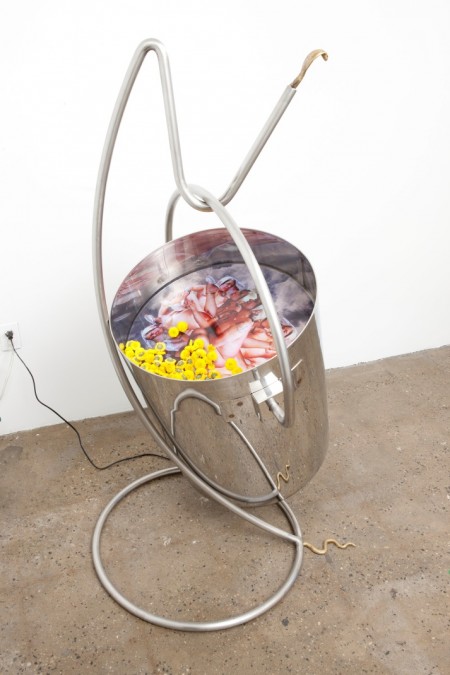
Genesis Breyer P-Orridge is one of those rare creatures in pop culture mythology who truly live up to their iconic name. Not only is the British punk rocker still active as ever at 66, touring regularly across the globe with industrial music pioneers Psychic TV, but s/he continues her lifelong pursuit of meaning with a singular devotion and commitment to artistic practice and creativity.
Despite h/er public persona as a racy provocateur, Genesis can be perfectly described as a romantic at heart. S/he’s fearless, yes, but s/he also exudes a sentimentality, mystical wisdom, and generosity of spirit that almost eclipse her legendary fame as a beloved enfant terrible.
This duality was on perfect display as Genesis sat down with curator Beth Citron at the Rubin Museum of Art, as museum staff eagerly anticipated the opening of her exhibition Genesis Breyer P-Orridge: Try to Altar Everything. In an intimate Q & A designed to illuminate the artist’s amazing life story and artistic practice, Beth chatted with Genesis about what inspires h/er work, and what visitors can expect to see in Try to Altar Everything.
*NOTE: Genesis uses the pronoun “we” and “our” to refer to h/erself and the Pandrogyne artistic identity Breyer P-Orridge, which consists of Genesis and h/er late romantic and creative partner, Lady Jaye. Genesis still considers Lady Jaye to be present.*
BETH CITRON: How would you describe your thinking and practice?
GENESIS BREYER P-ORRIDGE: Our practice, and the exhibition title, “Try to Altar Everything,” is about finding a contemporary way of presenting the everyday as sacred—a shamanic view of life. As you walk through life, the apparently mundane can be speaking to you in revelatory ways, but most people are too out of touch or wrapped up in their own head to notice. By re-combining everyday objects in new ways, we’re trying to prompt everyday spiritual awakenings and revelations.
Many of the objects in our artwork are possessions we’ve had for as long as twenty years before they become art. You need to live with it, let it gestate, and then you have an “aha” moment and it becomes obvious how you must use it. We tend to buy things that have some kind of energy, some kind of pull, and then let them tell us what they’ll become at the right moment.
The basic premise of our practice is that by looking at everything as having the potential to be sacred, we all have the capacity to make our lives more meaningful, enriching, and sustaining.
We’re always trying to stop and look at things in new ways—to reconsider the mundane in transformative ways. The universe is incredible and filled with miracles in the most banal places. When you look at the world in that way, it becomes energized in a profound way.
BC: What is Pandrogeny?
GBPO: We came to believe we truly were our other halves [referring to h/er late partner, Lady Jaye]. It was love at first sight, and we only felt whole when we were together. We wanted to become one new being as both, which is how the Pandrogyne project began.
It’s not about gender, or transcending a gender role; it’s about becoming something angelic, which is genderless. It’s about exploring how fully you can surrender to another by transcending your own body.
BC: What is your connection to Nepal?
GBPO: Kathmandu was the first place that we truly felt like we’d found home. As soon as you exit the plane, you feel like you’re on a psychedelic drug, because it’s so transporting and exotic.
In Kathmandu, devotion is everywhere, there are shrines and altars everywhere on the street. Sacred is part of everyday life there. We’ve lost that everyday connection to the spiritual and transcendent here, and we found it incredibly inspiring just to see.
BC: What’s the significance of the Begging Bin [below]?
GBPO: The Begging Bin is an enlarged version of the tins that beggars and wandering ascetics carry to ask for alms in Kathmandu”¦The Begging Bin represents an act of faith that the world will supply, that the Universe will provide. [The Begging Bin represents] our belief in destiny and the “of course” factor, which is that things happen as they’re meant to. Once you let go of all the reasons that you can’t or shouldn’t do something, you’re left with the incredible freedom to do absolutely anything. And that’s the path we chose.

Genesis Breyer P-Orridge: Try to Altar Everything was organized by Rubin Museum Curator Beth Citron and is on view at the Museum through August 1, 2016. Plan a visit to see the exhibition and learn more about Genesis Breyer P-Orridge.

